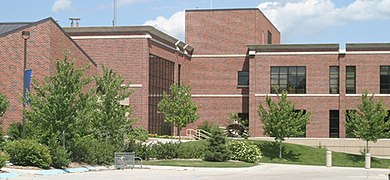Concordia University Nebraska
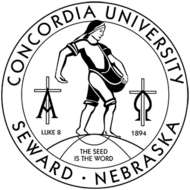 | |
Former names | Evangelische Lutherische Schullehrer Seminar, Concordia Teachers College (1924–1974), Concordia College (1974–1998) |
|---|---|
| Type | Private University |
| Established | 1894 |
Religious affiliation | Lutheran Church–Missouri Synod |
| Endowment | $54 million (2018)[1] |
| President | Bernard Bull |
| Provost | Timothy Preuss |
| Students | >2,300[2] |
| Undergraduates | 1,951[2] |
| Postgraduates | 768[2] |
| Location | , , United States
Coordinates: 40°54′51″N 97°05′27.35″W / 40.91417°N 97.0909306°W |
| Campus | Seward campus -Rural 85 acres (34 ha) Lincoln campus -Suburban |
| Colors | Navy and White |
| Athletics | NAIA – GPAC |
| Mascot | Bulldogs |
| Website | www |
 | |
Concordia University, Nebraska is a private Lutheran university in Seward, Nebraska, established in 1894. It is affiliated with the Lutheran Church–Missouri Synod as one of seven schools in the Concordia University System. The university is organized into three schools: the College of Arts and Sciences, the College of Education, and the College of Graduate Studies.
History[]
Founding and early years[]
Throughout the late 1880s there were efforts to establish a Lutheran teachers college in Nebraska. Efforts by four Seward businessmen, including the gift of 20 acres (8.1 ha) of land and $8,000, led the district to settle on Seward as the site for the college. The school, then named the Evangelische Lutherische Schulleherer Seminar (Evangelical Lutheran School Teachers Seminary), was officially dedicated on November 18, 1894.[3] Two days later classes began with its 13 students boarded, fed, and taught in the same building (now Founders Hall) by J. George Weller and his wife. Students were originally taught for three years before transferring to Addison Teachers Seminary to continue their instruction.
The academic programs were expanded in 1905 with the addition of two years of college studies so that students no longer were required to transfer to Addison. By 1908 a fourth year of high school was added to the program. Throughout the early years, the local community provided support to "The German College", as it was unofficially termed, including foodstuffs, housing, and funding. While most classes were conducted in German, English was also taught and used.[4]
- Historic Photos of Concordia University Nebraska
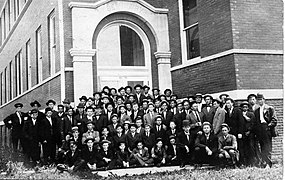
Concordia University Nebraska students in 1908

Concordia Nebraska band in 1908
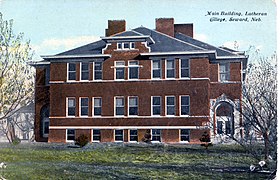
Becker Hall housed many activities before being demolished in 1999[5]

Tornado damage to Founders Hall - May 14, 1913

Concordia football team in the 1920s
With the outbreak of World War I in 1914, the school faced significant anti-German sentiment by the local populace despite Director Jesse's support as a Four Minute Man. In a demonstration of their American pride, the school changed the language of all its classes to English and constructed a 100 ft (30 m) flagpole, said to be the tallest in the county. After the war, the school was accredited as a junior college and became co-ed in 1919 although women boarded with families off-campus. In December 1918, the Lutheran Seminary, as the university was then named, suffered infection during the 1918 flu pandemic with at least 15% of the student body being infected and one student dying.[6] The school suffered another less-severe outbreak in 1920.
Concordia Teacher's College[]
| 1. | Rev. J. George Weller | 1894-1914 |
| 2. | Rev. F. W. C. Jesse | 1914-1923 |
| 3. | Rev. C. F. Brommer | 1924-1941 |
| 4. | Rev. Dr. A. O. Fuerbringer | 1941-1953 |
| 5. | Rev. Paul A. Zimmermann | 1954-1961 |
| 6. | Rev. Dr. W. Theophil Janzow | 1963-1977 |
| 7. | Rev. Dr. Michael J. Stelmachowicz | 1978-1984 |
| 8. | Dr. Ralph L. Reinke | 1986-1990 |
| 9. | Rev. Dr. Orville Walz | 1990-2004 |
| 10. | Rev. Dr. Brian Friedrich | 2004-2019 |
| 11. | Dr. Bernard Bull | 2021-Present |
The first bachelor's degrees were awarded in 1940, and the school became an accredited four-year institution in the late 1940s. In 1959, Concordia became the first of the LCMS schools to be accredited by the National Council for the Accreditation of Teacher Education. The school was named Concordia Teacher's College, reflecting the largest program until the addition of new fields of liberal arts majors in the 1970s. The school was again renamed, Concordia College, 1974-1998.
Additional educational and housing facilities were added as the university grew and expanded its programs, including science labs, a large library, and multiple residence halls. Business, art, science, and health-related programs were added to the teaching and pre-seminary courses. Graduate programs were added in 1968. With the increase in enrollment came new programs and professors, many who were housed along Faculty Lane.[8]
Recent changes[]
The college became part of the newly established Concordia University System in 1995. In 1996, the college hosted the first annual Plum Creek Children's Literacy Festival. The festival now brings nearly 10,000 school-aged students and teachers to campus to interact with authors and illustrators. It has included famous authors such as Lois Lowry, John R. Erickson, and Richard Peck.[9] and became a university in 1998 and was renamed Concordia University Nebraska. Concordia opened a 8,550-square-foot (794 m2) location in Lincoln's Fallbrook development to house graduate classes.
Throughout the 2000s Concordia's enrollment continued to grow with more students enrolling in programs outside the historical church-work degrees. Despite the growth of secular studies, the church-work programs continued to flourish with Concordia having graduated nearly 30% of LCMS church workers by 2019.[10]
In 2009, the Walz Health and Human Performance Complex was completed, significantly improving the athletic facilities and performance spaces.[11] The newest building on the campus is the Dunklau Center for Science, Math and Business, completed in 2019.[12] The Dunklau Center added 58,000 square feet (5,400 m2) primarily to the sciences while renovating existing spaces for other programs including the new agricultural program.[13]
The current president of Concordia University is Dr. Bernard Bull.[14]
Campus[]
The main campus is 85 acres (34 ha) in the town of Seward, Nebraska, with over 11 academic and administration buildings and 11 residence halls. The newest residence hall—Jonathan Hall—is an apartment-style-living facility. All of the campus's residence halls include internet access and cable telecommunications connections. The university grounds are home to a portion of the Nebraska Statewide Arboretum as well as a number of university-commissioned and student-made sculptures.
- Brommer Hall was originally built as a student center but was converted to a center for the arts. The building now contains offices, studio space, classrooms, and a computer lab.
- Bulldog Stadium was constructed in 1997 and hosts the athletic events of Concordia's track, football, and soccer teams in addition to intramurals and Seward High School football and soccer games.
- Founders Hall was originally built in 1894. As the original campus building, Founders supplied classrooms and living quarters for the first students, along with their teacher (Rev. J. George Weller) and his family. Currently, the Theatre Program's set-construction workshop operates in the basement. However, no classes meet in Founders Hall.
- Janzow Campus Center was recently renovated and is the hub of campus life. Janzow includes the dining hall and the Doghouse Grill, 10:31 Coffee House, John W. Cattle Conference Room, Student Success Center, game room and lounges, mail room, Student Activities Council Office (SAC), and the Bookstore.
- Jesse Hall was originally built in 1927 as a dormitory but now functions as office space for the business, communication, theology, and social science departments. Several classrooms and a computer lab are also present in the building. The Marxhausen Gallery of Art is located in the building with art visiting, original and archival shows on display. Jesse Hall also is the location for several organization offices including The Sower student newspaper and the Center for Liturgical Art, an outreach program to creates original pieces of ecclesiastical artwork for churches, schools, and religious organizations.
- Link Library houses over 230,000 titles, as well as the Bartels Museum, the Instructional Technology Center, and the Academic Resource Center and Writing Center.
- Music Center is the home for many performing arts studies at Concordia. Offices for the music department are located here as well as a number of practice rooms equipped with pianos and organs. In 2008, a Casavant Freres pipe organ was installed in the recital hall, Heine Hall, along with a new Steinway piano. A computer lab provides music students with software for composition. A black box theater in the basement of the center serves as a venue for intimate theatrical performances throughout the year. The building is currently under renovation to construct new rehearsal, performance, and recording facilities and is scheduled to be completed fall 2022.[15]
- The Osten Observatory houses a Meade LX-200 16” telescope in a Sirius Observatories 10-foot fiberglass dome. Students and faculty host regular public viewing in the spring and fall, and use the Meade DSI CCD imager for photography and research.
- The newly-renovated Dunklau Center hosts classes in science, mathematics, and business. The building includes laboratories for physics, biology, and chemistry with state-of-the-art equipment. The building also contains a greenhouse as well as a cadaver lab for the study of human anatomy.
- Thom Leadership Education Center (TLEC) includes many state of the art classrooms along with an auditorium, computer labs, and the offices of the education department.
- Walz Human Performance Complex and the Physical Education Building are home to athletics and the health and Human Performance department. Facilities include locker rooms, weight rooms, laundry and training facilities, a gymnasium and 2,000 seat arena, and a 200-meter indoor track and field house.
- Weller Hall is the administrative center of campus as it houses the business, marketing, admissions, financial service, and human resource departments. The offices of the provost and university president are also located in Weller. An auditorium hosts daily chapel services as well as theatrical productions. Weller also provides several classrooms for instruction.
- The Heartfelt Memorial features several sculptures and a garden dedicated to the memory of deceased children. It was completed in 2015.[16]
- Campus of Concordia University Nebraska
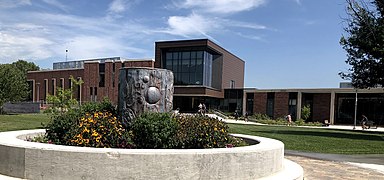
The Dunklau Center for Science, Math and Business is the most recently completed building on campus
The Thom Leadership Education Center was dedicated in 2000 and contains state-of-the-art classrooms, meeting rooms, and an auditorium. It houses education the offices of the College of Education and the Director of Christian Education program.
The Link Library contains about 232,000 titles and offers a Web-based cataloging and database systems. Bartels Museum houses fossils and minerals from around the world.

Bulldog Stadium was constructed in 1997 and hosts the athletic events of Concordia's track, football, and soccer teams in addition to intramurals and Seward High School football and soccer games.
Academics[]
The university is organized into three school—the College of Arts and Sciences, the College of Education, and the College of Graduate Studies. Concordia University, Nebraska is a fully accredited institution, accredited by the North Central Association of Colleges and Schools. The teacher education programs are accredited by the Council for the Accreditation of Educator Preparation (CAEP); music programs are accredited by the National Association of Schools of Music (NASM); and the institution's business program is accredited by the International Assembly for Collegiate Business Education (IACBE).
Undergraduate[]
Concordia awards bachelor's degrees in more than 50 undergraduate programs. In addition, the university awards the Lutheran Teacher Diploma, Christian Teacher Diploma, the Director of Christian Education, and Director of Parish Music certificate. Graduates of these programs serve as rostered church workers in the Lutheran Church–Missouri Synod. Pre-seminary and pre-deaconess programs are also available, including the necessary language courses to attend the seminaries of the LCMS.
Graduate[]
Concordia University offers several master's degrees. These programs offer a majority of their courses online. Most face-to-face classes meet in Lincoln, Neb.
Student life[]
Residence halls[]
There are currently 11 residence halls (dormitories) on the university's Seward campus. These dorms are separated by gender, with the exclusion of Jonathan Hall. The following is a list of the current Residential Halls:[17]
|
|
The dormitories are supervised by resident assistants and resident coordinators who are overseen by the Student Life Office.
Student government[]
The university's student senate is composed of one senator elected by their floor peers to represent their respective dorm floor. A proportionate number of senators are elected to represent students who live off campus, and a representative for the Student Activities Committee and Student Worship Committee. The president, vice president, secretary and treasurer are elected at-large from the entire student body. All official student groups also have a vote and their university funding is tied to attendance at the weekly meetings.
Extracurricular activities[]
Over 30 clubs and organizations exist on campus for students to participate in, ranging from service-oriented groups to intramural teams to academic support groups to honorary societies. The Sower is the university's bi-weekly newspaper. The Tower is the title of the institution's yearbook. The "Curtain Club" provides students with a medium of expression through drama. The Student Activity Committee (SAC) organizes multiple events for the student body throughout the year, including concerts, comedy shows, free movies, bowling nights and the popular Spring Weekend. Concordia also runs a Speech and Debate team coached by Joesph Davis as of October 2018.[18]
Traditions[]
Concordia hosts a number of traditions (institution organized and otherwise) throughout the year.
- Christmas at Concordia is an annual worship service during the first weekend in December. University musical ensembles perform as well as joining the congregation of St. John Lutheran Church in Seward, where the event is held. Four services are held throughout the weekend and tickets are required, but free.
- LAUNCH (formerly known as "Weekend of Welcome," or "WOW Weekend") is the orientation period for new students held in August. It features the "O-show", in which particulars of Concordia life are satirically portrayed.
- The "Naked Man" Run is an annual tradition held on the first snow of the year or early winter, during which students gather in Dorcas Hall and run wearing minimal clothing to the Son of Man, Be Free sculpture, or "The Naked Man," at the center of campus. Once there, the students form snow angels before retreating.
- Spring Weekend is the most prominent weekend at Concordia. The Student Activities Council organizes events in which teams compete. Historically, mud-volleyball and bed racing were part of the events but have since seen many changes. Popular events include the Lip-sync and sync-swim, in which students perform choreographed programs in child-sized pools.
- The Winter JazzFest and The Spring JazzFest are annual concerts featuring the Jazz Ensemble and the Jazz Vocal Choir. Various styles from the twentieth century are featured in the concert, from 20s jazz to 70s funk.
- Concordia Nebraska also hosts the "Gathering of the Talents" festival for elementary and middle school students from across the nation to experience artistic workshops.
The arts[]
Music[]
Concordia has more than a dozen vocal and instrumental faculty-led ensembles open to students:
- The University A Cappella choir, directed by Dr. Kurt von Kampen, was founded in 1939. The 70+ member choir performs both sacred and secular pieces of music and regularly makes national and international tours.
- Chamber Choir and Vocal Jazz Ensemble are 16 member choirs composed of students selected from the A Cappella choir. The choir regularly tours and sings a diverse array of music. It is directed by Dr. Kurt von Kampen.
- University Symphonic Band is composed of wind and percussion students through audition. It performs multiple times a semester at schools, churches and performance halls. The group is directed by Dr. Andrew Schultz.
- Male Chorus is a male vocal ensemble directed by Paul M. Soulek. The group performs several times a semester at chapel and church services as well as a culminating concert ending each semester. The group does not require an audition for entrance but uses one for placement for TTBB pieces.
- Women's Chorale, like the Male Chorus, performs throughout the semester both secular and sacred music and is directed by Dr. Jeffrey Blersch.
- University Jazz Ensemble conducted by Dr. Andrew Schultz is dedicated to the performance of instrumental jazz music. The group performs throughout the semester providing a winter and spring concert as well as swing music for the homecoming dance in October. Entrance is by audition.
- Concordia Brass Ensemble rehearses several hours each week and is directed by Dr. Wendy Schultz.
- Handbell choirs are directed by Jessica Kite and offer both Beginning and Advanced sections to students depending on experience and ability.
- Chamber Orchestra was restarted in 2011. The group includes strings, wind, brass and percussion students and community members desiring to play a classical repertoire.
- University Praise Bands perform contemporary Christian music at chapel services and makes trips to various special events.
- Bulldog Band is the university's pep band ensemble. It performs at home football, basketball and spirit events and travels for the annual Concordia Invitational Tournament. It is directed by Dr. Andrew Schultz.
Theatre[]
The Theatre Program generally stages 3 major productions each year, in addition to one-act plays, readers' theater and student-directed productions. The University's theater division has been included in Playbill, the yearly publication of the Alpha Psi Omega dramatic honor society, for more than 20 years. The Theatre faculty and students are active in the Region V Kennedy Center American College Theatre Festival. Students have received recognition for playwriting, directing, lighting design, set design and acting at regional festivals.[citation needed]
Visual arts[]
Concordia's art students publicly exhibit their artwork at the on-campus Marxhausen Gallery of Art (named after the artist Reinhold Marxhausen) for both the Annual Student Art Exhibition and the Bachelor of Fine Art Thesis Exhibition. The Marxhausen Gallery also intermittently hosts visiting artists from around the country who give presentations and display their art. The university's permanent collection of more than 300 works, the Koenig Collection, contains screen prints, etchings, lithographs and other original prints by nationally and internationally recognized artists. The Center for Liturgical Art at Concordia seeks to encourage and assist the Church in its ministry through the visual arts by promoting its use in worship. Students work alongside faculty and visiting artists to create a variety of pieces.[19]
Athletics[]
| Sport | Men's | Women's |
|---|---|---|
| Baseball | ||
| Basketball | ||
| Cheer and Dance | ||
| Cross Country | ||
| Esports | ||
| Football | ||
| Golf | ||
| Shooting Sports | ||
| Soccer | ||
| Softball | ||
| Tennis | ||
| Track & Field | ||
| Volleyball | ||
| Wrestling | ||

Concordia Nebraska athletic teams are known as the Bulldogs, and are part of the National Association of Intercollegiate Athletics (NAIA), primarily competing in the Great Plains Athletic Conference (GPAC) in 14 sponsored sports. The Bulldogs have won three NAIA National Championships: men's outdoor track and field (2015), women's outdoor track and field (2016), and women's basketball (2019). Concordia's softball team appeared in two Women's College World Series in 1970 and 1971.[20] The university also has many intramural sports.
Concordia Nebraska's teams use the newly constructed Walz Human Performance Complex, Bulldog Stadium, and Plum Creek Park baseball and softball fields for competitions.
Concordia Invitational Tournament (CIT)[]
Since 1950, Concordia has competed in an annual men's basketball tournament against other LCMS universities. A women's tournament was added in 1965. Throughout the history of CIT, Concordia Nebraska holds the best aggregate record in both the men's and women's tournaments.[21] Since 2001 the teams are: Concordia University, Nebraska, Concordia University Wisconsin, Concordia University Chicago and Concordia University, Ann Arbor.
The school mascot is the Bulldog.
Notable people[]
Alumni[]
- Dan Cloeter - Runner including winner of the 1977 and 1979 Chicago Marathon
- Jeanne Combs - Nebraska state representative from the 32nd District from 2003 to 2007
- Toby Down - Professional soccer player
- Mary Ann Hanusa - Iowa state representative from 2011 to 2021
- Alice Hausman - Member of the Minnesota House of Representatives
- Amanda Husberg - Composer of hymns
- Kenlon Johannes - Businessman and CEO of Kansas Soybean Commission and Association
- David Morgan - Professor and scholar
- Brian Mueller - President of Grand Canyon University
- Tom Mueller - College football coach
- John Seevers - College football coach
- Roby Smith - Iowa state senator from the 47th District since 2011
- Annette Sweeney - Iowa state senator from the 25th District since 2018 and member of the Iowa House of Representatives 2009-2013
- Robert Sylwester - Emeritus professor of education at the University of Oregon and recipient of awards for cognitive neuroscience research
- Andrea von Kampen - folk singer-songwriter
Faculty[]
- Bernard Bull - University president and scholar
- Ron Harms - College football coach
- Alan Harre - University president and administrator
- Reinhold Marxhausen - Artist
- Ralph Starenko - College football coach
References[]
- ^ "Concordia University-Nebraska | Data USA". datausa.io. Retrieved 2 September 2021.
- ^ Jump up to: a b c "Total Enrollment Breaks Record at Concordia University, Nebraska". Retrieved 10 March 2015.
- ^ Pfabe, Jerrald (23 September 2018). "History of Concordia: The Founding and Early Years of Concordia University, 1894-1919". The Sower Newspaper. The Sower. Retrieved 28 August 2020.
- ^ "History of Concordia". Concordia University, Nebraska. Retrieved 28 August 2020.
- ^ Sylwester, Mike (1 May 2009). "Campus Buildings That Are Gone". Seward Concordia Neighborhood. Retrieved 28 August 2020.
- ^ Pfabe, Jerrald (Summer 2020). "Of Uncertain Origin". Broadcaster. 97 (2): 14–15.
- ^ Sylwester, Mike (8 December 2009). "Seward Concordia Neighborhood: The Order of Concordia Presidents". Seward Concordia Neighborhood. Retrieved 28 August 2020.
- ^ Rensner, Hayden (6 March 2019). "Faculty Lane Houses Bring Back Memories". The Sower Newspaper. Retrieved 28 August 2020.
- ^ "Festival History". Concordia University, Nebraska. Retrieved 28 August 2020.
- ^ Sheafer, Jayne (8 November 2019). "Observe 'Concordia University, Nebraska Sunday' on Nov. 17". Reporter. Retrieved 28 August 2020.
- ^ Knabel, Jacob. "Concordia University celebrates 125 years with state-of-the-art science building". JournalStar.com. Retrieved 28 August 2020.
- ^ http://interesttime.org/dreaming-big-at-concordia-universities-nebraska-and-wisconsin/
- ^ Dunker, Chris. "Concordia University celebrates 125 years with state-of-the-art science building". JournalStar.com. Retrieved 28 August 2020.
- ^ Dunker, Chris (24 August 2021). "Concordia installs Bull as 11th president". JournalStar.com. Retrieved 2 September 2021.
- ^ Magness, Cheryl (17 June 2021). "CUNE breaks ground on new performing arts center". Reporter. Retrieved 2 September 2021.
- ^ "MEMORIAL". heartfeltseward.org. Retrieved 31 August 2021.
- ^ "Dorm Room Layouts at Concordia Nebraska". Concordia University, Nebraska. Retrieved 3 September 2021.
- ^ "Clubs and Intramurals at Concordia Nebraska". Concordia University, Nebraska. Retrieved 3 September 2021.
- ^ "About". The Center for Liturgical Art. Retrieved 3 September 2021.
- ^ Plummer, William; Floyd, Larry C. (2013). A Series Of Their Own: History Of The Women's College World Series. Oklahoma City, Oklahoma, United States: Turnkey Communications Inc. ISBN 978-0-9893007-0-4.
- ^ "History of the CIT". Concordia University. Archived from the original on 26 November 2014. Retrieved 22 August 2013.
External links[]
| Wikimedia Commons has media related to Concordia University (Nebraska). |
- Concordia University Nebraska
- Universities and colleges affiliated with the Lutheran Church–Missouri Synod
- Great Plains Athletic Conference schools
- Education in Seward County, Nebraska
- Buildings and structures in Seward County, Nebraska
- Private universities and colleges in Nebraska
- Educational institutions established in 1894
- 1894 establishments in Nebraska








